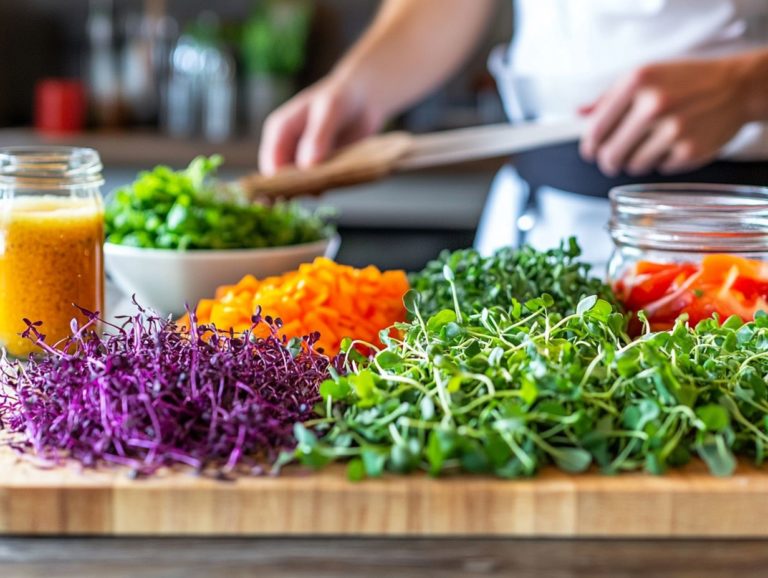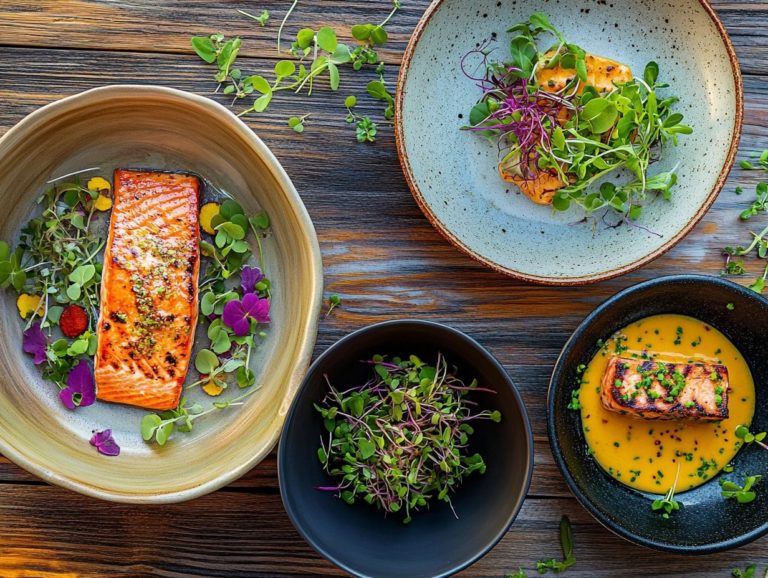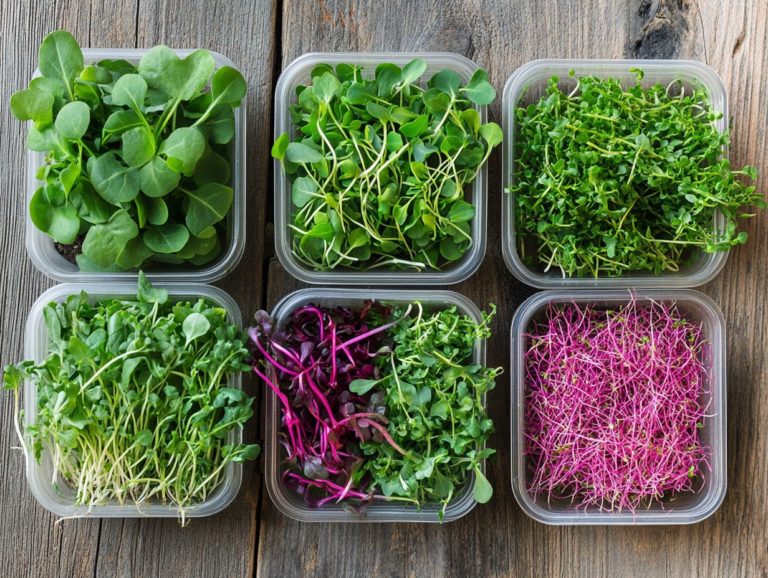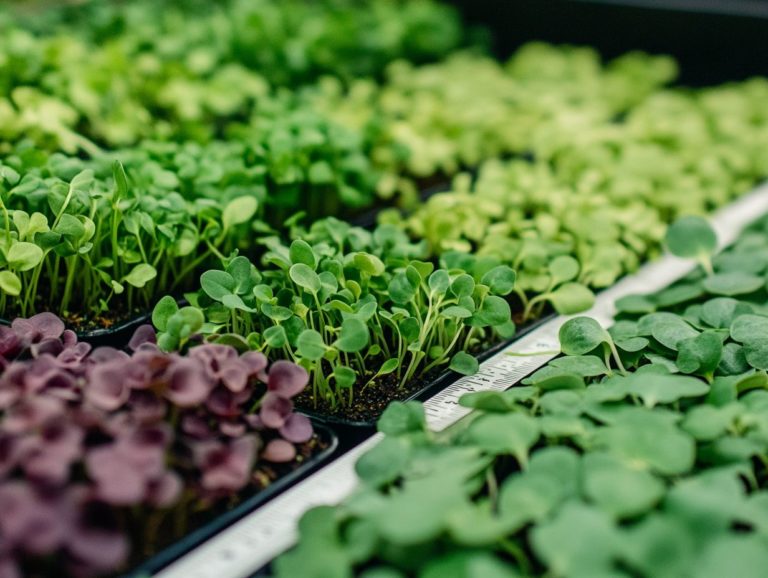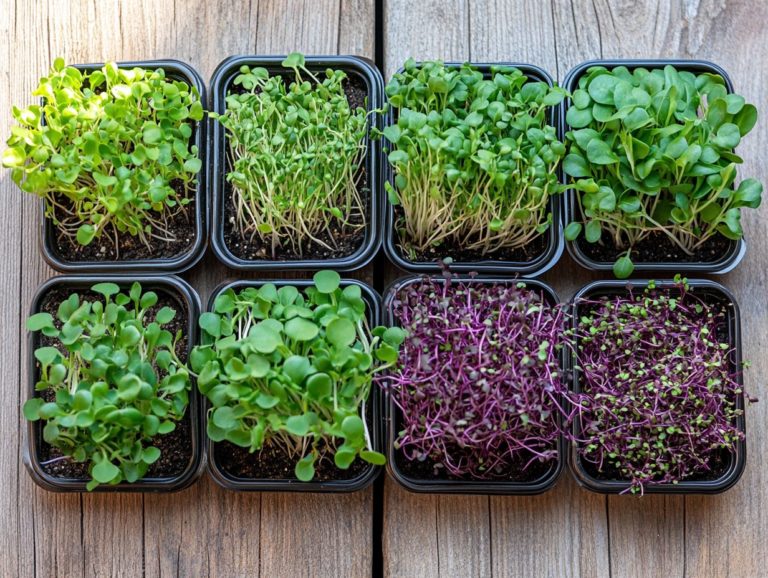5 Microgreen Varieties for Flavorful Wraps
Microgreens are little powerhouses of flavor and nutrition, making them an essential addition to your wraps. With a variety of microgreen options, you can elevate your meals in exciting new ways.
Consider five standout varieties: Radish, Sunflower, Pea Shoots, Broccoli, and Beet Microgreens. These easy-to-grow greens can truly enhance the flavor of your dishes.
Discover how to cultivate these nutritious greens right at home with a simple guide. You ll also learn the myriad health benefits of incorporating them into your wraps.
Find tips on storing microgreens to keep them fresh for your culinary creations.
Get ready to transform your wraps into something extraordinary with nutrient-dense microgreens!
Contents
- Key Takeaways:
- 1. Radish Microgreens
- 2. Sunflower Microgreens
- 3. Pea Shoots
- 4. Broccoli Microgreens
- 5. Beet Microgreens
- How to Grow Microgreens at Home?
- Frequently Asked Questions
- What are 5 microgreen varieties that are perfect for flavorful wraps?
- How does arugula enhance the flavor of wraps?
- Why is cilantro a popular choice for wraps?
- What makes radish microgreens stand out in wraps?
- How do sunflower microgreens contribute to the flavor of wraps?
- What makes pea shoots a versatile option for wraps?
Key Takeaways:
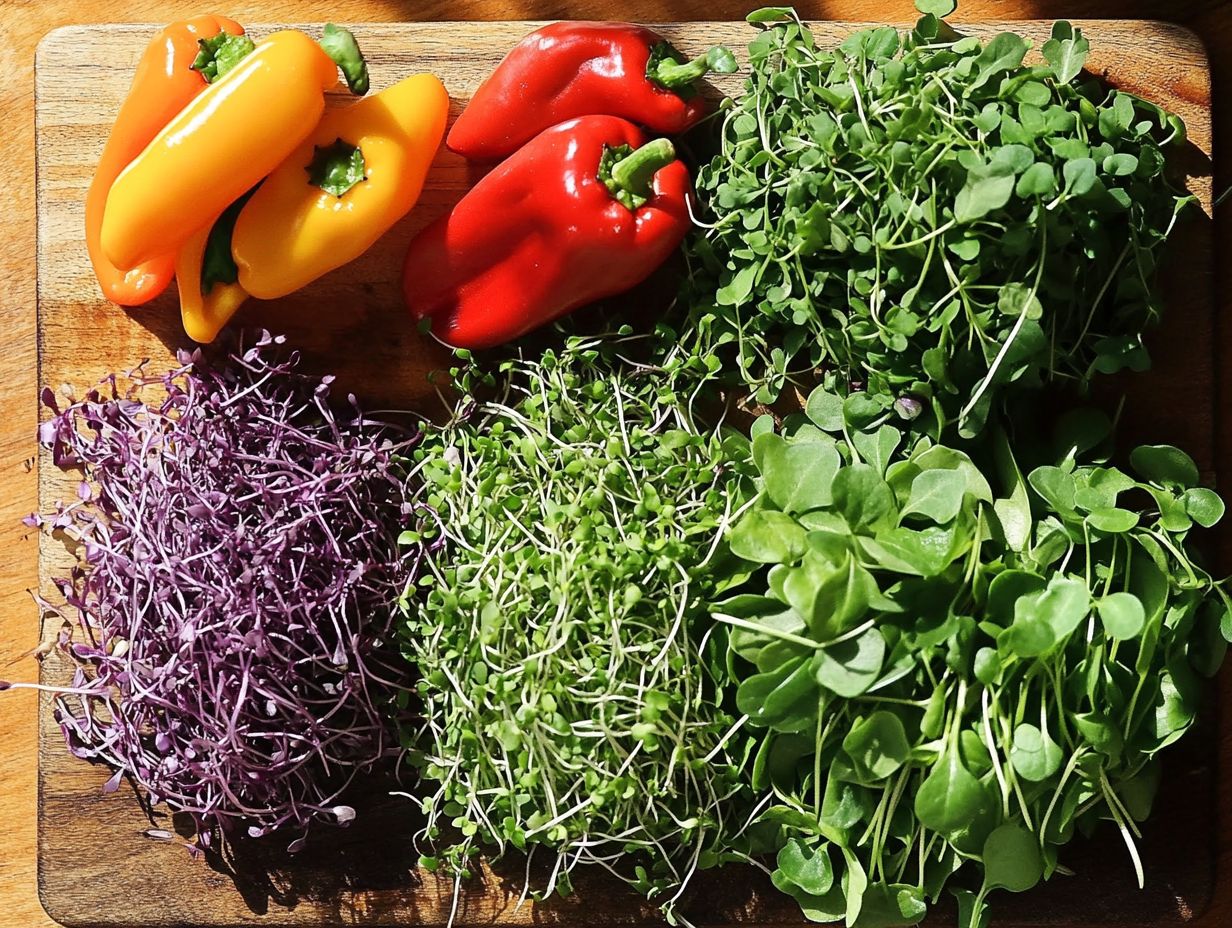
- Radish, sunflower, pea shoots, broccoli, and beet microgreens are five delicious and nutritious varieties that can elevate the flavor of your wraps.
- Growing microgreens at home is a simple and cost-effective way to incorporate them into your diet.
- Microgreens are versatile and can be used in various wraps, such as lettuce wraps, tortilla wraps, and rice paper rolls.
1. Radish Microgreens
Radish microgreens are a vibrant and nutrient-packed addition to your indoor gardening setup. Celebrated for their quick sprouting and unique flavor profiles, they elevate everything from salads to sandwiches.
Rich in vitamin C, these tiny greens provide a delightful crunch and deliver a significant boost to your immune system. Food lovers often find creative ways to use radish microgreens whether sprinkling them over a fresh salad, layering them in a wrap for extra texture, or using them as a garnish atop soups and entrees.
Their ease of cultivation aligns perfectly with sustainable gardening practices. You can grow these nutritious microgreens using organic seeds right on your kitchen countertop, minimizing your environmental footprint while nurturing a self-sufficient lifestyle through winter gardening.
2. Sunflower Microgreens
Sunflower microgreens are a breeze to grow and bursting with nutrients perfect for anyone keen on adding living foods to their diet.
These vibrant little greens are rich in vitamins and antioxidants, especially vitamin E, which is essential for protecting your cells from oxidative stress and enhancing skin health. Imagine adding their delightful nutty flavor to your salads, sandwiches, and smoothies what an upgrade!
If you’re facing space or lighting challenges, growing sunflower microgreens indoors is entirely doable, even in low light conditions. All you need is a shallow tray filled with soil, placed by a window or under full-spectrum lights. Just remember to establish a watering routine and watch for mold to ensure a thriving crop.
3. Pea Shoots
Pea shoots are a delightful microgreen variety that you’ll likely come to adore. With their sweet flavor and remarkable nutrient uptake, they are a favorite in microgreen recipes.
These tender greens are brimming with vitamins A, C, and K, making them a true powerhouse for anyone eager to elevate their diet with fresh produce. They can be effortlessly cultivated in shallow trays, perfect for those with limited space or gardening experience.
Growing them indoors aligns beautifully with eco-friendly gardening practices, reducing the need for transportation and packaging. Plus, you ll enjoy a continuous supply of fresh greens throughout the year. This commitment to sustainable gardening is a win-win for both your palate and the planet.
Start your microgreen journey today!
4. Broccoli Microgreens
Broccoli microgreens, along with broccoli sprouts, are a true powerhouse of nutrients, renowned for their impressive health benefits. They re packed with vitamins A and C and serve as beneficial prebiotic foods that promote gut health, supporting a well-rounded diet.
These tiny greens are particularly abundant in antioxidants, which help combat oxidative stress and reduce inflammation in your body. Adding them to your diet is not just smart; it s a decision that elevates your overall wellness, especially when integrated into microgreens recipes.
Ready to grow these nutritious gems right in your home? It s crucial to start with good quality seeds and a well-draining soil mix, such as organic or non-GMO seeds.
They flourish in bright, indirect sunlight and require consistent moisture to thrive, ensuring ideal growth conditions.
When it comes time to harvest, aim for the leaves to be fully developed yet still tender typically around harvest time of 7 to 14 days after germination. This ensures that their vibrant flavor and health benefits remain intact, giving you the best of what these microgreens have to offer in terms of flavor profiles and nutrition.
5. Beet Microgreens
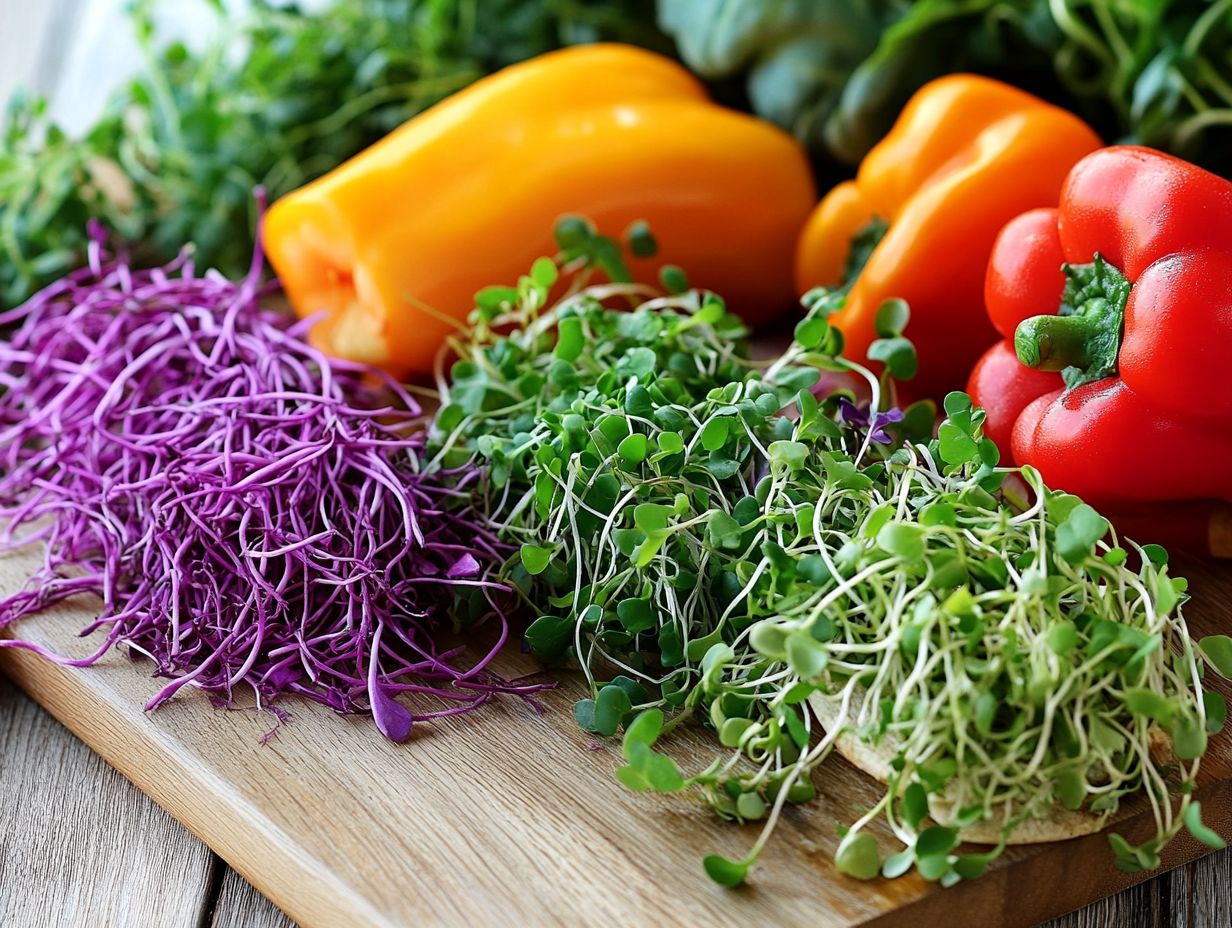
Beet microgreens are a nutrient-dense food option that not only elevate the flavors of your salads and dishes but are also ideally suited for container gardening, making them perfect for urban gardening enthusiasts like you.
These petite greens are brimming with vitamins A, C, and K, along with essential minerals, delivering a powerful boost to your overall health thanks to their high nutrient content. Their unique earthy and slightly sweet flavor profile adds a delightful touch to a range of culinary creations, from gourmet plates to your favorite home-cooked meals, making them perfect for Buddha Bowls as well.
If you re keen on cultivating these vibrant microgreens, starting them in small trays or repurposed containers is an excellent choice, as they thrive in compact spaces with adequate drainage, supporting sustainable gardening practices.
By following a few simple steps like maintaining consistent moisture and providing natural sunlight you can quickly enjoy the fresh taste and amazing benefits of beet microgreens right in your home.
How to Grow Microgreens at Home?
Learning how to grow microgreens at home is an exciting journey into indoor gardening, presenting a straightforward guide for health-conscious individuals like you who wish to cultivate nutrient-rich foods in a variety of growing conditions, including both low light and natural sunlight.
This process helps you enjoy fresh flavors and offers a simple planting guide. Choose a microgreens kit that fits your needs, including options for sprouting seeds, and you can embark on this rewarding experience with enthusiasm.
The next step is to sow seeds evenly, ensuring ample growth and yield. Establishing a consistent watering routine is vital for ensuring the success of your indoor gardening efforts.
It s essential to maintain optimal growing conditions, including humidity and temperature, as these factors significantly impact the success of your microgreens, especially in eco-friendly gardening.
With a little patience and attention to detail, you ll find yourself reaping a bountiful harvest of flavorful microgreens.
What Are the Benefits of Incorporating Microgreens into Wraps?
Incorporating microgreens into your wraps offers substantial health benefits while elevating the flavor. They transform a simple meal into a healthy meal packed with nutrients.
These tiny greens are rich in vitamins, minerals, and antioxidants. They often boast nutrient concentrations far greater than their mature counterparts, making them an attractive choice for health-promoting meals.
By including them in your wrap recipes, you enhance both taste and nutritional value. Whether you opt for a classic lettuce wrap, a sandwich, or a bold Mediterranean-inspired choice, their culinary versatility allows seamless integration into diverse flavors.
Microgreens complement everything from savory protein options to zesty dressings, adding unique flavor profiles. This sparks creativity in the kitchen and makes healthy eating enjoyable using easy-to-grow microgreens.
What Are the Different Types of Wraps That Go Well with Microgreens?
You ll find a delightful variety of wrap types, such as lettuce leaves, tortillas, and rice paper, that beautifully complement microgreens. These options offer endless possibilities for flavor enhancement and culinary creativity in your health-focused meals, perfect for urban gardening.
Lettuce wraps provide a crisp and refreshing base. They allow the natural flavors of microgreens like arugula, radish, or mustard greens to shine, delivering a zesty kick.
Tortillas, whether flour or corn, serve as a versatile canvas. Vibrant microgreens like cilantro, basil, or sunflower sprouts can elevate your wraps with a fragrant, herbaceous note.
Rice paper wraps introduce a slightly chewy texture, making them perfect for pairing with delicate microgreens like pea shoots or broccoli sprouts. These add a subtle sweetness and create a satisfying balance.
Each wrap type not only boosts nutritional value but also contributes unique textural experiences, transforming simple ingredients into delightful meals you ll savor.
How Can Microgreens Add Flavor and Nutrients to Wraps?
Microgreens can elevate your wraps by adding both flavor and nutrients. They enrich your dishes with vibrant colors and diverse taste profiles while delivering essential health benefits.
For instance, arugula microgreens introduce a subtle peppery kick that pairs beautifully with creamy spreads and protein-rich fillings. Radish microgreens offer a zesty crunch, enhancing flavors in both vegetarian and meat-based wraps.
Sunflower microgreens bring delightful texture and are packed with vitamins E and B. These vitamins support skin health and boost your energy.
With such a variety of tastes and health advantages, incorporating these tiny greens promotes your well-being in every bite. Try adding arugula microgreens to your next wrap for an instant flavor boost!
What Are the Best Ways to Use Microgreens in Wraps?
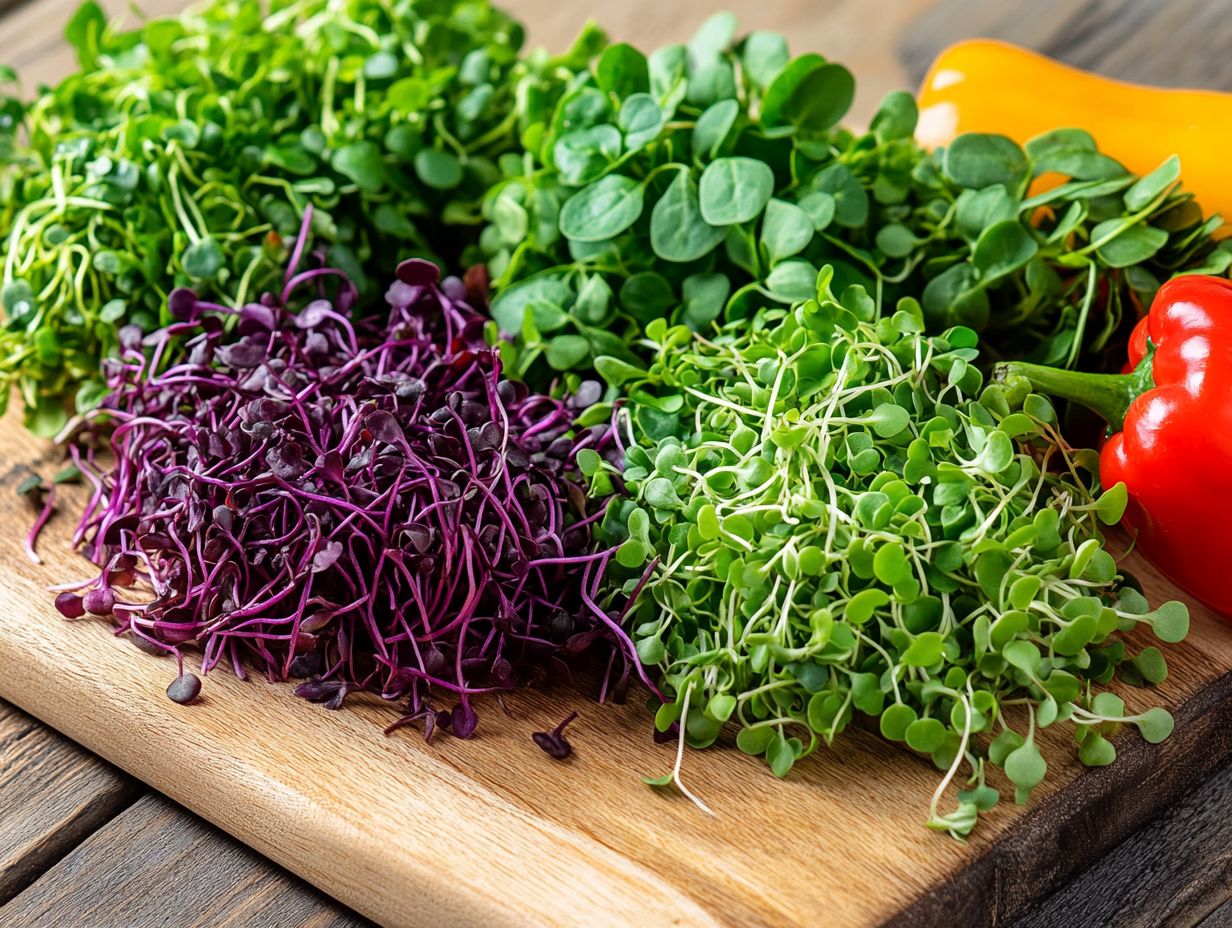
Layer microgreens for that perfect texture, mix them with proteins for a satisfying bite, and incorporate them into flavorful sauces to craft a balanced, nutritious meal. You can easily find microgreen varieties that suit your taste preferences.
To elevate your wraps, combine spicy microgreens like arugula or radish sprouts with a creamy avocado spread. This enhances the taste while boosting health benefits.
Another exciting option is to pair delicate pea shoots with grilled chicken or tofu, allowing the natural sweetness of the peas to shine through.
Drizzle homemade lemon vinaigrette over your layered ingredients to tie all the flavors together. Don’t forget to integrate a handful of cilantro or basil microgreens; they add a fresh burst that brightens each bite, ensuring your wraps are both delicious and visually stunning. For an extra boost, consider adding some of the top microgreens for smoothies to your dishes.
How Can One Store Microgreens to Keep Them Fresh?
Storing microgreens properly keeps them fresh and ready for your meals! Proper storage is essential for preserving their freshness and extending their shelf life.
By following some best practices, you can savor the vibrant flavors and health benefits these tiny greens deliver. Keep them in a cool environment, ideally between 34 F and 39 F, to prevent wilting.
Choose breathable containers that promote air circulation, such as perforated plastic bags or clamshells. Avoid washing them before storage; moisture can hasten spoilage. Instead, wash them just before use to maintain their delightful crunchiness.
By adhering to these guidelines, you ll keep your microgreens as fresh as they were on the day they were harvested.
Frequently Asked Questions
What are 5 microgreen varieties that are perfect for flavorful wraps?
The 5 microgreen varieties perfect for flavorful wraps are arugula, cilantro, radish, sunflower, and pea shoots. These greens are easy to grow and can thrive even in low light conditions.
How does arugula enhance the flavor of wraps?
Arugula has a peppery and spicy taste that adds depth and kick to wraps. Its slight bitterness balances sweet and savory ingredients. When used in a Buddha Bowl a one-bowl meal filled with various healthy ingredients or in a salad, it truly shines.
Why is cilantro a popular choice for wraps?
Cilantro has a unique and refreshing flavor that pairs well with ingredients like avocado and lime. It also adds a pop of green color to wraps.
Its foods that help good bacteria in your gut characteristics contribute to gut health.
What makes radish microgreens stand out in wraps?
Radish microgreens have a sharp and slightly spicy taste that adds a bold flavor to wraps. Their crunchy texture contrasts beautifully with soft wrap ingredients.
They grow quickly, making them a favorite among sustainable gardening enthusiasts.
How do sunflower microgreens contribute to the flavor of wraps?
Sunflower microgreens have a nutty and earthy taste that adds depth and richness to wraps. They’re packed with nutrients and add a delightful crunch to the dish.
With high levels of vitamin A and vitamin C, they truly elevate your wraps!
What makes pea shoots a versatile option for wraps?
Pea shoots have a mild and slightly sweet taste that complements a wide range of wrap ingredients. Their delicate and tender texture adds a refreshing element to the dish.
The growing conditions for pea shoots are quite favorable, making them a popular choice.

